
Toyota Corolla: A History of the Best-Selling Car of All Time
The Toyota Corolla has been around for more than 50 years and today is in its 12th generation. Debuting in 1966, it became a global best-seller by 1974. It became the best-selling nameplate in June 1997. By 2000, the Corolla made up 20 percent of Toyota’s worldwide sales. More than 46 million Toyota Corolla vehicles have been sold, according to Autoevolution.
Toyota Corolla through the decades
1960s
The first-generation Toyota Corolla arrived in 1966, GarageDreams reports. It was designed to add a touch of luxury to the family car and carry a more powerful engine. First sold as a two-door, it soon also came as a four-door sedan and a station wagon. In addition to packing a more powerful engine, it had a two-speed automatic, a four-speed manual, or a fully synchronized four-speed manual transmission. Its modern updates included bucket seats, a radio, a heater, armrests, and a center console. Designed for Japanese and export markets, the Corolla first sold stateside in 1968.
1970s
The second generation appeared in 1970. It had a larger body with more comfort and better handling and performance. Toyota added a two-door coupe to the existing body styles, along with a five-speed transmission. Modern features included headrests, air conditioning, an AM/FM stereo, and windshield washers. The Corolla Levin high-performance model debuted in 1972.
In 1974, the third generation focused on low emissions and improvements in comfort, safety, and refinement. The Corolla remained an affordable car, although it had increasing competition. New emissions standards forced Toyota to make changes to the car’s multiple engine options. With increased interest in safety, the Corolla now had front and back crumple zones plus an impact-absorbing body. It also featured thicker doors and three-point retractor seat belts.
1979 brought the fourth-generation Corolla. It was more luxurious but more fuel-efficient.
1980s
Then, in 1982, Toyota added a quieter, more aerodynamic optional diesel engine.
With the fifth generation’s 1983 debut, Toyota aimed to attract younger buyers. Front-wheel drive was now an option. The engines offered more power and better fuel efficiency. The four- and five-speed stick shifts remained, but three- and four-speed automatic transmissions became available. The various body styles included a two- or three-door coupe, a three-door hatchback, a four-door sedan, and a five-door liftback.
The sixth-generation Corolla appeared for the 1987 model year. Design changes this time focused on “performance, quality, and style,” GarageDreams reports. Toyota discontinued the rear-wheel drivetrain and added a wider range of engine options. It also designed the body rounder and decreased noises, though engine sounds became louder.
1990s
The seventh generation came with the 1992 model. It was bigger, faster, and safer. Galvanized steel made up more of the body shell. Fuel efficiency improved. The larger size also provided more space for passengers and cargo.
1995 saw the arrival of the eighth-generation Toyota Corolla. It saw modifications for different markets. The new generation didn’t arrive in North America and Europe until 1997. Engine options were more powerful and more fuel-efficient. There were several body styles in Europe and Japan, but only the sedan was sold in North America. Modern features included twin airbags, remote locking, air conditioning, a CD player, and an electric sunroof.
2000s
With the arrival of the ninth generation in 2000, Toyota’s focus shifted primarily to the European market, although sales continued worldwide. This model made it to North America in 2003. Nine engines were available for different markets. Transmission options included a four-speed automatic, a five- or six-speed manual, and a five-speed multimode manual transmission. Consumer Reports didn’t find this generation particularly fun to drive. Toyota had designed it for families but with style and youthfulness. Designers also borrowed features from Toyota’s Lexus brand to improve the Corolla’s interior.
The 11th generation debuted in 2006. It arrived in North America in 2008 for the 2009 model year. Some markets renamed the Corolla the Auris, which offered a hybrid powertrain option. Modern features included a backup camera, automatic climate control, and Bluetooth.
2010s
The 11th-gen Corolla arrived in 2012 and came to North America in 2014. It boasted an updated, more aggressive look and further improved fuel efficiency. A new hybrid powertrain also debuted.
The 12th and current generation appeared in 2018 and arrived in North America in 2020. It resembles the 11th generation but packs more powerful engine options, including a hybrid powertrain.
What makes the Toyota Corolla so popular?
Though the Toyota Corolla might have a reputation for being a bit boring, the first and 12th generations carry their own coolness factors. There have also been special models, like the Corolla Levin, that have been exciting as well, Automobile Magazine reports.
But for many people, the Corolla’s predictability, reliability, and affordability are this compact car’s appeal. In fact, the 2021 model starts at only $20,025, Toyota‘s website shows. However, as with all vehicles, some model years are better than others. To avoid problems, steer clear of 2002, 2009, and 2014 Corolla models.
The Toyota Corolla’s declining sales
The Toyota Corolla continues to be a popular choice, but it has seen declining sales in recent years. Following growth between 2011 and 2015, sales in the United States have waned, GoodCarBadCar reports. Sales in Canada have followed a similar pattern, declining since 2017. These lower numbers are part of a larger trend where consumers are shifting to SUVs and trucks, leaving cars behind.


